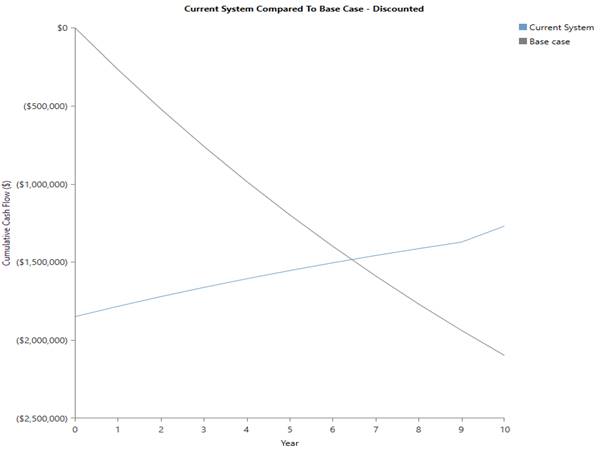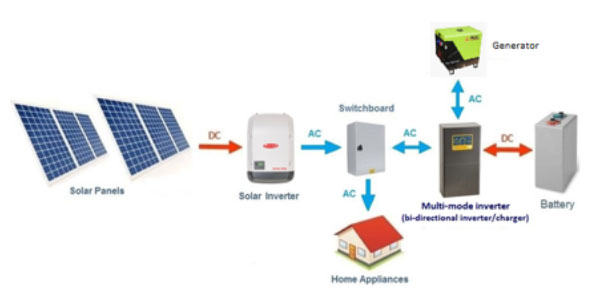Off-Grid Energy/Stand Alone Power Supplies (SPS)
Do you have a property in a remote location that requires power? Our team of professional system designers will work with you in order to design and quote a world-class energy system that will meet your energy and power requirements while meeting your budget. Call our team at Anova energy today to discuss our design philosophy and the technology that we recommend.
Solar, wind turbines and battery prices have fallen dramatically over the past ten years mean that, in many cases, installing an off-grid energy system can be cheaper than connecting to the grid. If the closest grid connection point is fifty meters or more from the home/business, then it is possible that an off-grid energy system (with close to zero emissions and minimal ongoing costs) may cost a similar amount to a grid connection. Our engineers have years of experience consulting with clients, identifying grid connection and energy costs and identifying/designing the most cost-effective renewable energy system to meet the clients needs and budget.
ANOVA offers a range of off-grid energy systems to meet any application. Remote telecom sites, off-grid homes and businesses. ANOVA has a wealth of experience designing and optimising energy systems for clients across the country. We use high-quality equipment designed meticulously in order to ensure that the client is never left without energy.
Anova have prepared some information to work as a guide for clients looking into off grid energy systems for the first time
STEP 1: Demand Profile Analysis
The first step in designing an off-grid energy system is identifying the average daily demand for the winter months. There are a number of ways to estimate this. If the client wishes to take an existing property off the grid, then the information can be found on existing energy bills. If the project is a new build, then an artificial load profile must be estimated. All equipment that is to be used must be listed along with estimated run times. Please download and fill out our load calculator and feel free to contact our design team so that they can assist you.
STEP 2: Solar Yield Estimation
Use local data from the Bureau of Meteorology (BOM) to estimate solar yields.
(This step is to be done by our design team as shading effects and reindentation need to be considered)
Please note, all yields are estimates only and are based on Melbourne Airport solar data.
A home or business with a daily demand of 10kWh located at the same latitude as Melbourne will require a 6kW PV array in order to meet their daily energy demand during the winter months. A graph of estimated average solar yields V daily energy demand is shown below.
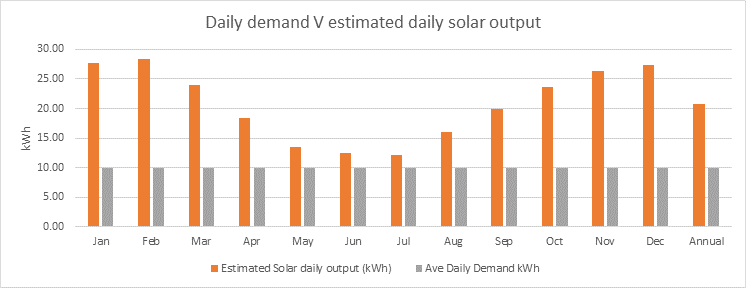
A home or business with a daily energy demand of 20kWh would require a 10 to 14kW system in order to meet the daily demand through winter.
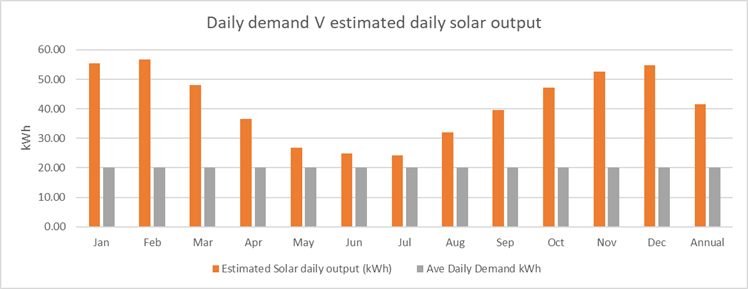
A facility with a 40kWh/day demand may require a 20kW PV system to meet the demand during winter.

A home or business with a daily energy demand of 20kWh would require a 10 to 14kW system in order to meet the daily demand through winter.
STEP 3: Battery sizing/battery selection
A large percentage of the cost of a renewable energy system comes in the form of batteries. Standard SAPS design recommends three days of battery autonomy (how many days the site can run off backup battery power without renewable energy input); however, in many cases, this may be cost prohibitive. A reduction in the days of autonomy will result in the backup generator running more often during periods of bad weather.
The required lifetime of the system will often determine technology selection. AGM Lead acid batteries are some of the cheapest on the market. However, the life of such a battery can be significantly shorter than a lithium-ion battery. If the life requirement of a system is only two to four years, then AGM batteries may be a cost-effective solution. If the system needs to operate for seven to ten years, then a Deep Discharge Valve Regulated Lead Acid (VRLA) such as BAE batteries are likely to be a more robust and cost-effective solution. Once a battery system is expected to last longer than ten years, Lithium-Ion batteries, VRLA batteries and Super Capacitors are all valid options. Please talk to one of our design engineers to discuss the best solution for your application, system life and budget.
STEP 4: Sizing the generator
Increasing the size of the generator only marginally increases the capital cost of an off-grid system. Usually, a generator is selected that has the power capacity to run the entire site. Factors such as sound levels, RPM and fuel type are often considerations. ANOVA works with all leading generator brands.
Example systems with an indicative price range

Example system 1
Daily demand = 10kWh
Price Range – $20,000 to $60,000
The price depends on a number of factors, maximum power requirement, location, roof type, Panel selection, Inverter selection, battery selection (size and technology), generator fuel type and selection, monitoring, design life and other design/installation factors.
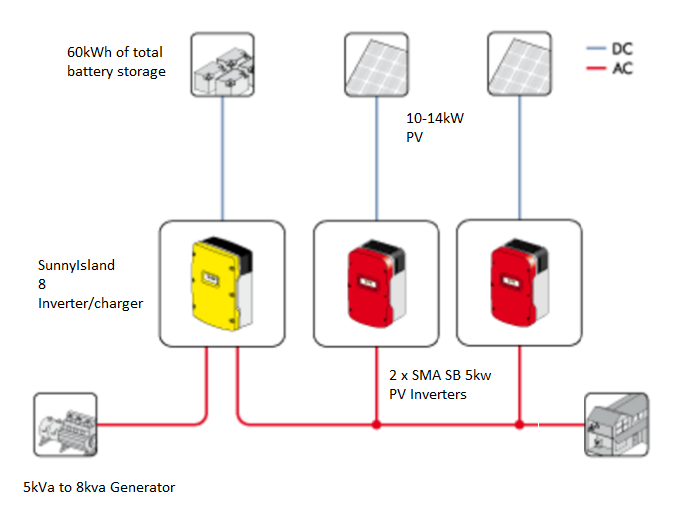
Example system 2
Daily demand = 20kWh
Price Range – $30,000 to $100,000
The price depends on a number of factors, maximum power requirement, location, roof type, Panel selection, Inverter selection, battery selection (size and technology), generator fuel type and selection, monitoring, design life and other design/installation factors.

Example System 3
Daily Demand = 40kWh/day
Estimated Price Range $55,000 to $150,000
The price depends on a number of factors, single or three phase requirement, maximum power requirement, location, roof type, Panel selection, Inverter selection, battery selection (size and technology), generator fuel type and selection, monitoring, design life and other design/installation factors.
Economics
ANOVA Energy’s reports are highly detailed and accurate allowing our clients to feel confident that the estimated economic performance of any system is going to be very close to real-world performance. Efforts are made by our designers to overestimate losses and underestimate yields so that real-world savings exceed initial estimates. Our team can optimize system architecture based on the payback period, carbon abatement or overall savings.
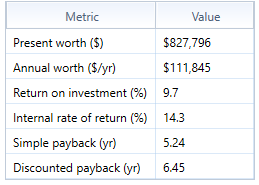
AC coupled energy system
Most of the energy systems (grid connected and off grid) are AC coupled. This means that solar energy is produced, fed through a solar inverter to the home or business. Any additional energy is then used to charge a battery. This energy is then used when the site load is larger than the power supplied from solar. We always recommend a backup generator to allow for times of extreme energy demand or prolonged bad weather.
DC coupled energy system
DC coupled energy systems work a little differently. Solar energy is fed to the battery system through a charge controller. This method is often used for small to medium energy systems as DC coupled system often require the solar modules to be connected in parallel, creating high current, which can result in higher energy losses. Three phase hybrid inverters suitable for off grid applications are also limited. Our system designers can assist you in identifying the most suitable energy system design for your application.
Design
ANOVA utilize HOMER PR, PV syst and SAM software in order to identify optimal energy system design and technology selection on a case by case basis. Our designers assess a large number of variables while consulting with the client to clearly define important system design parameters.
We will work with the end user to work out exactly what they want then analyse the site, budget, energy demand and a range of other factors to design the optimal solution for that application.
Please see our design and consultancy page to gain a more in depth understanding of how ANVOA can approach designing the optimal energy system.

Solar modules
- LG
- Opal
- Trina
- Canadian
- Jinko
- And more
Backup Generators
- PRAMAC
- Honda
Wind turbines
Batteries
- BYD
- Opal Storage
- LG Chem RESU series
- BAE VRLA Batteries
- Arvio Super Capacitors
- Flow batteries
- Salt water batteries and many more

